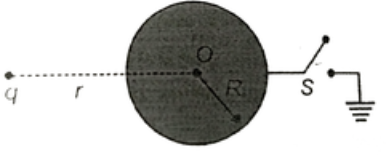Using Gauss. theorem, obtain an expression for intensity of electric field .E. at a point which is at a distance r (r>R) from the centre Cof a thin spherical shell (of radius R) carrying charge.Q.
To find the expression for the intensity of the electric field E at a point which is at a distance r (where r>R) from the center C of a thin spherical shell of radius R carrying charge Q, we will use Gauss's law. Here’s the step-by-step solution:
Step 1: Understand the Setup
We have a thin spherical shell of radius R with a total charge Q uniformly distributed on its surface. We want to find the electric field at a point P located at a distance r from the center of the shell, where r>R.
Hint: Visualize the spherical shell and the point outside it. Remember that the charge is uniformly distributed on the surface.
Step 2: Apply Gauss's Law
Gauss's law states that the electric flux ΦE through a closed surface is proportional to the charge enclosed Qenc by that surface:
ΦE=Qencϵ0
Step 3: Choose a Gaussian Surface
We choose a Gaussian surface that is a sphere of radius r (where r>R) centered at the same point as the spherical shell. This Gaussian surface encloses the entire charge Q of the shell.
Hint: The symmetry of the problem allows us to use a spherical Gaussian surface.
Step 4: Calculate Electric Flux
The electric field E is uniform over the surface of the Gaussian sphere due to symmetry. Therefore, the electric flux through the surface can be expressed as:
ΦE=E⋅A
where A is the surface area of the sphere, given by 4πr2. Thus,
ΦE=E⋅4πr2
Step 5: Relate Electric Flux to Charge Enclosed
Since the Gaussian surface encloses the charge Q, we can write:
ΦE=Qϵ0
Step 6: Equate the Two Expressions for Electric Flux
Setting the two expressions for electric flux equal gives us:
E⋅4πr2=Qϵ0
Step 7: Solve for Electric Field E
Now, we can solve for E:
E=Q4πϵ0r2
Step 8: Express in Terms of Coulomb's Constant
Recognizing that k=14πϵ0, we can rewrite the expression for the electric field as:
E=kQr2
Final Expression
Thus, the intensity of the electric field at a distance r from the center of the spherical shell is given by:
E=Q4πϵ0r2orE=kQr2
We have a thin spherical shell of radius R with a total charge Q uniformly distributed on its surface. We want to find the electric field at a point P located at a distance r from the center of the shell, where r>R.
Gauss's law states that the electric flux ΦE through a closed surface is proportional to the charge enclosed Qenc by that surface:
We choose a Gaussian surface that is a sphere of radius r (where r>R) centered at the same point as the spherical shell. This Gaussian surface encloses the entire charge Q of the shell.
The electric field E is uniform over the surface of the Gaussian sphere due to symmetry. Therefore, the electric flux through the surface can be expressed as:
Since the Gaussian surface encloses the charge Q, we can write:
Setting the two expressions for electric flux equal gives us:
Now, we can solve for E:
Recognizing that k=14πϵ0, we can rewrite the expression for the electric field as:
Thus, the intensity of the electric field at a distance r from the center of the spherical shell is given by:
Similar Questions
A conducting sphere of radius R is charged to a potential of V volts. Then the electric field at a distance r(>R) from the centre of the sphere would be
View SolutionWhich one of the following graphs represents the variation of electric field with distance r from the centre of a charged spherical conductor of radius R?
View SolutionA hallow metal sphere of radius R is uniformly charged. The electric field due to the sphere at a distance r from the centre:
View SolutionFigure shows a uniformly charged thin non-conducting sphere of total charge Q and radius R. If point charge q is situated at point 'A' which is at a distance r<R from centre of the sphere, then find out following :
(i) Force acting on charge q.
(ii) Electric field at centre of sphere.
(iii) Electric field at point B.

View SolutionState Gauss's theorem in electrostatics. Apply this theorem to derive an expression for electric field intensity at a point outside a uniformly charged thin spherical shell.
View SolutionA point charge q , is placed at a distance r from the centre of an aluminium sphere, of radius R (r>R) . Selectr the correct alternatives.

View SolutionAn isolated solid metal sphere of radius R is given an electric charge. The variation of the intensity of the electric field with the distance r from the centre of the sphere is best shown by
View SolutionUsing Gauss's law obtain the expression for the electric field due to uniformly charged thin spherical shell of radius R at a point outside the shell. Draw a graph showing the variation of electric tield with r, for r gt R and r lt R.
View SolutionUsing Gauss's law obtain the expression for the electric field due to uniformly charged thin spherical shell of radius R at a point outside the shell. Draw a graph showing the variation of electric tield with r, for r gt R and r lt R.
View SolutionA conducting shell of radius R carries charge–Q. A point charge +Q is placed at the centre of shell. The electric field E varies with distance r (from the centre of the shell) as :
View Solution
